- Home
-
SHOP ECO FARM
- ECO Farm Grow Lights
- ECO Farm LED Grow Lights
- ECO Farm Quantum Board
- ECO Farm Samsung LED Grow Lights
- ECO Farm COB Grow Lights
- ECO Farm Commercial Lights
- ECO Farm Supplemental Grow Light
- ECO Farm Fluorescent grow lights
- ECO Farm HPS & MH Grow Lights
- ECO Farm CMH Grow Lights
- ECO Farm HID/CMH Bulbs & Ballasts
- ECO Farm Grow Tents & Kits
- ECO Farm 2x2ft Grow Kits
- ECO Farm 3x3ft Grow Kits
- ECO Farm 3.3x3.3ft Grow Kits
- ECO Farm 4x4ft Grow Kits
- ECO Farm 5x5ft Grow Kits
- ECO Farm Grow Tent - Standard Style
- ECO Farm Grow Tent - Extension & Roof & Lodge Style
- ECO Farm Extraction & Harvest
- ECO Farm Rosin Press Machine
- ECO Farm Dry & Wet Trimmers
- ECO Farm Oil Accessories
- ECO Farm Medicinal Plants Grinder
- ECO Farm Medicinal Plants Containers
- ECO Farm Medicinal Plants Dryer
- ECO Farm Refrigeration Dryer
- ECO Farm Climate Control & Other Accessories
- ECO Farm Inline Duct Fans
- ECO Farm Oscillating Fans
- ECO Farm Exhaust Fans
- ECO Farm Air Filter
- ECO Farm Duct Muffler
- ECO Farm Ventilation Kits
- ECO Farm Plant Humidifiers
- ECO Farm Plant Dehumidifiers
- ECO Farm Hydroponic Accessories
- ECO Farm Other Accessories
- ECO Farm Hydroponics Microscopes
-
TOP BRANDS
- Grow Lights Brands
- Adjust-A-Wing
- Apollo Horticulture
- Bestva
- Black Dog LED
- California Lightworks
- ChilLED Grow Light
- Eco Farm
- HLG - Horticulture Lighting Group
- Kingled
- Kind LED
- Mars Hydro
- Morsen
- Neilo
- NextLight
- Phlizon
- PlatinumLed
- Roleadro
- Optic LED Grow Lights
- ViparSpectra
- Vivosun
- EYE Hortilux
- IPOWER
- NanoLux
- Phantom grow light
- Gavita grow lights
- Grower's Choice
- Lumatek
- Maxibright
- Yearld Pro
- ThinkGrow
- Crecer Lighting
- Green Sunshine Electric Sky
- fohse aries
- loriflux
- luxx
- fluence
- iluminar
- Lex
- LTC
- Rayonled
- FGI
- PHOTONTEK
- Grow Tents & Kits Brands
- Apollo Horticulture
- Black Box
- CoolGrows
- Eco Farm
- GrowLab
- Gorilla Grow Tents
- Mars Hydro
- Quictent
- Secret Jardin
- Unit Farm
- TopoGrow
- VIVOSUN
- Topolite
-
COMPANY INFO
-
COOPERATE WITH US
- Blog
What is the best LED grow light for small grow tents 2021 Update?
May 05, 2021
Most of us live in cities nowadays. Stuck in the concrete jungle, we believe that gardening is not available to us. Even growing small plants in pots isn’t possible if you have a small balcony. And having a backyard garden for most sounds like a dream.
small grow tents are great for growing seedlings, succulents, fruits and vegetables in a small controlled indoor environment. These small sized grow tents are typically three to four feet high instead of the five to seven foot height of a full sized grow tent.Lights, smell, and watering all stay within the tent. In other words, the shelter makes you the god of your own garden, in the comfort of your own home.
There is a limited range of quality small LED grow lights in the 50 watt to 150 watt range for small grow spaces of 2ft x 2ft or 60cm x 60cm.
LED grow light efficiency
Dividing the usable PAR output of the LED grow light by its consumed power (watts drawn from the wall) we can calculate the efficiency of the fixture in PAR output per watt. To achieve a high system efficiency the grow light must use the best power supplies (LED drivers) and a high quantity of LEDs (LEDs run more efficiently when each one is run at lower current, more LEDs per watt = higher efficiency). So higher LED grow light efficiency is a very strong indicator of a high quality fixture.
Higher LED grow light efficiency also means lower heat from the fixture. Heat is a result of low efficiency where the LED drivers and lights will run hotter and increase the temperature in the grow area. This is a particular problem when growing in a small grow tent as more heat means running fans and AC at higher speeds to remove the heat resulting in more fan noise and odour leakage. Higher efficiency = more stealthy growing.
Let's introduce the actual wattage LED grow light suitable for small grow tents on the market!
ECO Farm 120W LM301B Classic Quantum Board

★ Samsung LM301B Diodes with high energy efficiency 2.7umol/J.Using the Newest high-yield LED technology-266 pcs Samsung LM301B diodes mix 660nm 760nm 395nm. Provides a much longer service lifetime, you can easily save money without purchasing lights frequently and pay less in electricity bill.
★ Sunlike Spectrum Light uniformly across the surface and deep into the roots and bottom of canopy for consistent, highest quality crops.
★ Fanless design makes your growing life easy and quiet. Perfect for indoor plants growing.
★ Fool-style operation, no need to assembly, simple Plug-and-play. Whether you're a growing newbie or veteran, Classic Series lights will make your plants happy and yield more.
Specification:
Veg Footprint: 3 x 3 ft
Flower Footprint: 2 x 2 ft
Max Yield:2.5g/watt
Humidity ≤90%
Lifespan: ≥50000 hours
View Angle of LED:90°-120°
Spectrum:3000K+ 660nm+IR 760nm+UV 395nm
Frequency: 50-60HZ
Input Voltage: AC100-277V
Draw power: 120W±5%@AC120V, 115W±5%@AC240V
Work Temperature:-4°F ~115°F (-20°C ~ 46°C)
Lenofocus MX1200 LED Grow Light Full Spectrum Dimmable LED Grow Lights

Features:
◆Brand new design, beautiful looking.
◆Famous LED brand: CREE J Series 3030 LEDs.
◆Special LED matrix design, improve light distribution.
◆90°optical lenses increase light penetration.
◆Sunlightbasics spectrum: warm white 3000K, white 5000K, red 660nm and infrared 730nm.
◆Special designed LED driver mount.
◆Dimmable LED driver, UL approved and waterproof.
◆Support 3 dimming methods. Dimmer is not included.
◆Larger heat radiation area than other brands quantum boards.
◆You can use this light to DIY your own indoor growing systems.
◆You can use one Lenofocus dimmer to dim 1-4 units.
◆You can use one 0-10V dimmer or PWM dimmer to dim many this lights.
◆You can connect this light to a smart growing system which can output 0-10V signal.
◆If no dimmer, the light will work as a non-dimmable light.
◆If you want to dim the light, you can search Lenofocus dimmer and buy one, or buy one from other brands.
Specifications:
Model No.: MX1200
Power Draw: 122W ±5%
Input Voltage: AC100-277V 50/60Hz
Input Current: 0.43 – 1.2A
LED Power: 180pcs 1W LED
Spectrum: 3000K, 5000K, red 660nm and infrared 730nm
Beam Angle: 90°
Dimming Type: 0 ~ 10VDC, or 10V PWM signal or resistance
Light Board Size: 406x230x16mm/16×9.06×0.39in
Net Weight: 2.7kg/5.95lb
LED driver is waterproof, LED light board is not waterproof.
Carambola 1000W LED Grow Light 2x2 ft LED Grow Light

Product Description
PPF: 275 μmol/s
Efficacy:2.2 μmol/J
Max Yield: 2.0 Lbs/six lights
Power Consumption: 115W (1.05A110VAC/0.48A240VAC)
LEDs actual Watt: 100W
LEDs: 288 pcs (180pcs 3500K white LEDs, 86pcs Wideband Full RED LEDs, 18pcs Purple LEDs, 8pcs UV LEDs)
LED Chip: SANAN 1231*2
Total chip area: 0.2 square in
Input power: 100-240VAC 50/60Hz
Power Factor: >0.9
Light Spectrum: 380nm~800nm full spectrum including 450nm/660nm/730nm
Light B:GY:R:FR : 12%:30%:48%:8%
Light Best For: flowering and fruiting plants during growth and flower stage
Light Mounting Height: 12-20in above canopy
Light PPFD (μmol/ m²/s ) (stage: h=mounting height A=canopy coverage ):
400 μmol/m²/s (Vegetative: h=16in A=2X2ft)
580 μmol /m²/s (Flower: h=12in A=1.5X1.5ft)
Light Operating Temperature: -20℃ t0 40 ℃
Light Operation place: indoor
LED chip soldering pad temperature: 70℃ (at room temperature 28℃)
Power Driver: aluminum housing and Thermal sealant
Warranty: 3 Years
Light Net Weight: 1.0kg , 2.20lbs
Light Dimension(inch): 12(L)x12(W)x2.3(H)
ECO Farm ECOZ 1000W LED Grow Light VS ECO Farm ECOM 1000W LED Grow Light Bars
April 23, 2021
How Much Light Do You Need?
Once you’ve decided which kind of plant grow light you want, it’s time to decide how big a bulb you need for the space you have. First, determine how much space you need to illuminate. As a rule, you want 30 to 40 watts per square foot. Divide the wattage of your light by 30 (such as 1,000 divided 30 = 34), then divide the wattage of your bulb by 40 (1,000 divided by 40 = 25).
The answer gives you the extremes of your light intensity range. With one 1000 watt LED Grow Light, you can light between 25 and 34 square feet of interior landscape. Also, be sure to match the wattage of your light with what your fixture is designed to handle.Adjust your setup as you observe how well your plants grow. Increase or decrease the intensity of the light by shifting the placement of your plants or light fixture so the plants are closer or farther from the light source.
ECO Farm LED grow Light has so many models , now let’s compare their differences!
ECO Farm ECOZ 1000W LED Grow Light

- Industry top efficacy and light output - 2.9 μmol/j ;
- Save 100%-200% on lighting compared to other brands;
- Reduce HVAC and electricity costs by 50-60%;
- Make you get 30% Higher Yield compare the traditional lamps, Increases revenue with better quality flower and higher yield(maximize crop yield by growing vertical).
- Built with the best parts ,Top Bing Samsung & Osram Chip and brand driver for higher efficacy and longer lifespan;
- Most trustable Full-cycle Sunlike Spectrum with proven result, optimized for rapid growth and complete plant development;
- Chanels Dimmers, VEG switch , Bloom switch ,UV switch separatly controlled, Freely adjust the lamps according to different growing stages;VEG dimmer to control white light 5000K, one Bloom dimmer to control white light +red light ( 3000K+660nm+730nm), and UV dimmer to control UV 395nm.
- Plug & Play design, The light bars are 'clip in' and 'clip out' making for super easy assembly and maintenance.


Specification:
Model Code:ECOZ 1000
Power Draw (W):1000W MAX
LEDs:
Samsung LM301H (5000K+3000K)
Osram ssl80(660nm+730nm)
Refond (395nm)
Dimmension(CM):112*112*10.6cm
Dimmable (Manual/ Controller):Manual/Controller
Input Voltage:Autosensing 100-277V
3 Channels:Veg/Bloom/UV Individually control
VEG Coverage MAX:6' x 6'
Bloom Coverage MAX:5' x 5'
Efficiency (umol/j):2.9
PPF:1920
Mounting Height:18” - 24” above canopy
Max. Ambient Temperature:95°F / 35°C
Operating Temp:20°C ~ 40°C (-4°F ~ 104°F)
Lifetime:>100,000hrs
Packaging Size:119*33*27cm
Warranty:5 Years
ECO Farm ECOM 1000W LED Grow Light Bars

Designed with Samsung LM301B chip, higher light intensity, less light decay , better lumens and PAR values than ordinary leds. It runs at a lower temperature and can bring higher energy conversion and longer life. This grow light is a full-cycle lighting solution for all growing environments including wet situation and is ideal for greenhouse or indoor lighting.
Lower temperature , more scientifically and energy-efficient. Making you get 30% higher yield than HPS.
No fans no noise and waterproof function. Lots of heat sinks and hollow body ensures maximum heat dissipation. No additional fan zero noise. Otherwise, the plant grow light uses advanced waterproof power supply which is installed outside of the light and it is easy to be replaced.

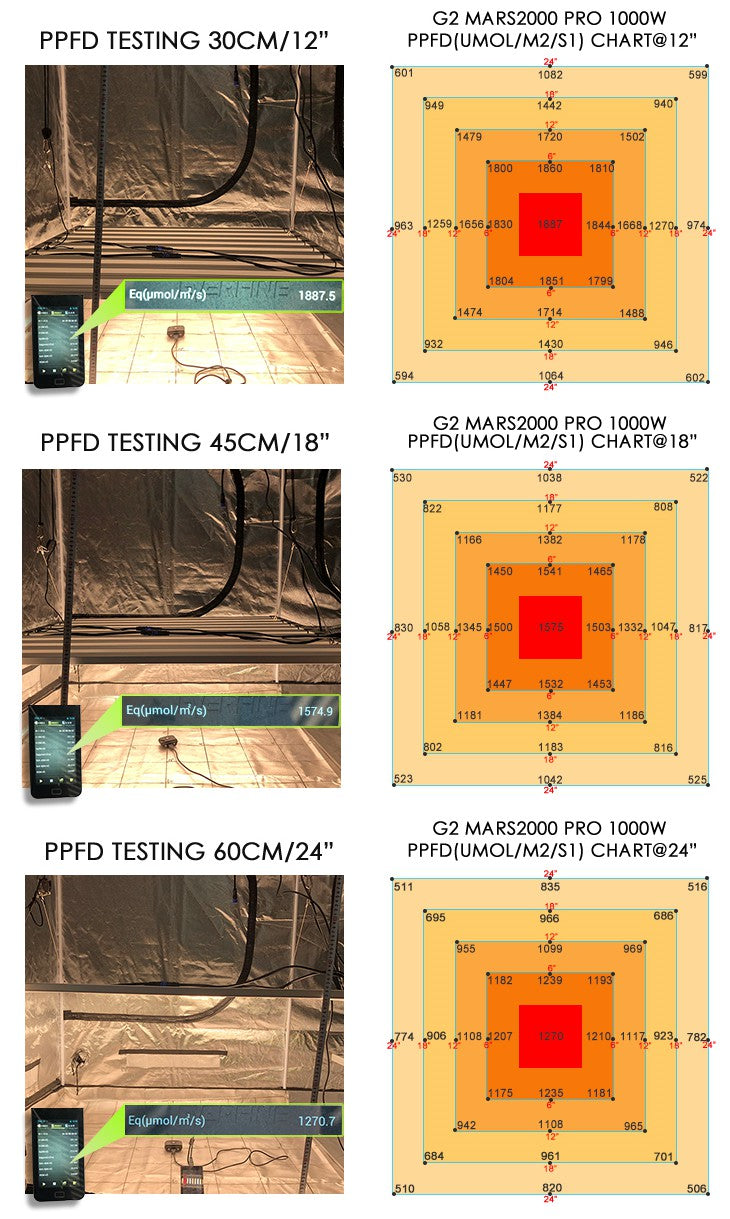
Specification:
Model Code:ECOM 1000
Power Draw (W):1000W MAX
LEDs:
LM301B 3000K 192pcs x8
LM301B 6500K 96pcs x8
OSRAM 660nm 12pcs x8
Dimmension(CM):112.2*112.2*3.5cm
Dimmable (Manual/ Controller):Manual
Input Voltage:Autosensing 100-277V
VEG Coverage MAX:6' x 6'
Bloom Coverage MAX:5' x 5'
Efficiency (umol/j):2.5
Max. Ambient Temperature:95°F / 35°C
Operating Temp:20°C ~ 40°C (-4°F ~ 104°F)
Lifetime:>100,000hrs
Warranty:3 Years
Crecer Lighting VertX 600 LED VS LEX Grow 1800+ 640 Watt Commercial LED Grow Light
April 22, 2021
If you are looking to buy an indoor grow light, Here we have reviewed, rated, and compared the 8 best full spectrum LED grow lights you should definitely consider.
Sure, there is nothing wrong to go for regular LED grow lights, but these full spectrum LED grow lights offer some advantages that you need to consider if you want to ensure successful plant growth.
Full spectrum grow lights have the unique ability to mimic the sun’s natural UV ray production. For indoor gardeners, these lights are a must-have item to ensure successful plant growth.
The lighting is an excellent long-term investment that pays for itself with reduced energy consumption, prolific plant growth, and a bountiful harvest.
Crecer Lighting VertX 600 LED

VertX 600 Led Grow Lights has top bin samsung LM301D Full spectrum white led + 660 nm red diodes which delivers industrial leading PPF output of 1720 umol/s with up to 2.82 umol/J efficiency. This robust Led Grow Light uses foldable robust design and 6 bar technology delivers uniform amount of light over the canopy. VertX specifically design for shelve or rack mounting application. Remote mounting driver technology allows to dissipate heat faster. The fixture had on-board dimming function as well as easily daisy chain for dimming with many controllers available in the market.
0-10V On Board Dimming Capabilities
The VertX 600 can be equipped with 0-10V On Board Dimming with controller dimming functionality which enables light intensity to be adjusted dynamically. The grower can control the amount of light on the crop at any time. This not only improves crop quality but also helps achieve efficient and sustainable growth in a controlled climate.
Full Spectrum White Light Output
Full Spectrum White Light induces your plants to undergo natural photorespiration. While that will force them to work harder, it also leads to more efficient nutrient intake. You end up with sturdier plants, healthier growth, and increased yields.

Product Features
- LED Chips: Samsung LM301D White with 660nm Red Diodes
- Housing Material: Aluminum
- Finishing: Oxidation
- IP Rating: IP66 Waterproof
- PPF Output: 1720 umol/s
- Efficiency: 2.82 umol/J
- Thermal Management: Passive Cooling
- Operating Temp: -20 to 40 degree C
- Beam Angle: 120 degree
- Thermal Management: Passive Cooling
- Operating Temp: -20 to 40 degree C
Electrical
- Input Power: 610 W
- True Power from Wall: 610 W
- Input Voltage: 120V - 277V
- Power Factor: 0.99
- Dimming: 0 - 10V (On Board Dimming)
Listing & Certifications
- Lifespan: 100,000 hours
- Listing: Horticulture UL8800 standards
- Warranty: 3 Years Limited
LEX Grow 1800+ 640 Watt Commercial LED Grow Light

-
Consuming only 640 Watts
-
Manual Knob Dimming Capable 0%-100%
-
The Built in RJ 14 Ports Allow the Lex Grow 1800+ to be linkable with Master Controllers
-
The LEX Grow 1800+ is composed of MeanWell Drivers, Samsung white LEDs, and Osram deep-red LEDs. This light is built to last, and is backed by an industry leading 7 Year Warranty
The Lex Grow 1800+ produces a high intensity full spectrum light designed to efficiently replace any DE 1000w HPS on the market. Using only 640 watts, this light is perfect for growers looking to cover larger areas using less. The 1800+ covers a 5 ft x 5 ft flower footprint and a 7 ft x 7 ft veg footprint. This unit is backed by Lex Commercials industry leading 7 year warranty. This distinction means each unit is covered by a 7 year full manufacturer’s warranty, has a 100,000 hour life rating, is ETL listed and you will never have to change a bulb again.
The Lex Grow 1800+ is designed to meet the needs of commercial and home growers alike. We understand excessive power consumption, bulb replacements and heat are the biggest problems indoor growers face. The Lex Grow line alleviates all of those issues. Coming in at over 2.8 PPF/Watt, the Lex Grow is the most efficient full spectrum LED, period.
Lex Grow 1800+ Full Spectrum provides the same sun-like qualities plants love without the negatives of high energy requirements and high heat. Using Lex Grow Full Spectrum LED you will see faster growth and most importantly increased production overall.
Specifications
-
Flower Footprint: 5 ft x 5 ft
-
Veg Footprint: 7 ft x 7 ft
-
PPF: 1800
-
Wattage: 640w
-
PPF/Watt: 2.8
-
Built in RJ 14 Ports
-
Wei Xuan HuangRJ 14 Cord
-
Unit Dimensions: 44.4 in x 44.4 in
-
Life Rating: 100,000 hrs
-
Warranty: 7 Years Full
-
Operating Volts: 120v - 277v
-
ETL Certified and IP66 rated
-
No Bulb Replacements
Included in Box
-
1 x Lex Grow 1800 + Fixture
-
2 x V-Hooks
-
2 x Adjustable Ratchet Hangers
-
1 x Power Cord - (optional 120/240/277)
-
1 x Instruction Manual
-
1 x RJ 14 Cord
Technical Specifications
-
Operating Voltage100-277 VAC
-
Operating Frequency60 Hz
-
Input Current
-
5.4A @ 120V
-
2.8A @ 240V
-
2.5A @ 277V
-
How Many Grow Lights Do I Need for 8x8 Grow Tent? 2021 Update
April 20, 2021
Grow up to 24 medium to large plants or 30 smaller plants in our 8x8 ft grow tent. These monstrous grow tents will require a spare room or garage to be set-up in due to their large size. The 8x8 footprint of this these tents will need about four or so 600 watt or equivalent grow lights to fully cover the space. These easy-to-assemble grow tents are great for managing the growing environment, maintains any mess created from the grow process, and helps keep your plants free of any outside pests or contaminants from outside.
Watts per square foot
To grow marijuana, you want between 30 and 40 watts per square foot of grow space. Of course, more wattage will give you larger yields (within reason) and less wattage will result in smaller yields.
NOTE: We are using the actual power here not the rated power. LED diodes are never run at full power, as this would considerably shorten their life. A 3-watt chip for example, will only run at approximately 60% of full power.
So if a fixture has two hundred 3-watt diodes, it is technically capable of producing 600 watts of power, but it will actually only draw about 300 to 400. Most amazon product will list the rated power (600 watts), but this is obviously a bit misleading.
Total power needed=grow area in sq ft*30W sq ft (to 40W/sq ft)
So For 8*8 area (64sq ft)
64sq ft*30W sq ft =1920watts
64 sq ft*40W sq ft =2560watts
So, continuing the example from above, 8*8 grow tent need between 1920 and 2560 watts of actual LED power
The Optimal PPF for Cannabis:
PPFD is a density measurement which is expressed as micromoles per square meter. To convert PPFD into a quantity measurement, we multiply it by the area in square meters. Since the optimal average photon density is 700 µmol/m2 (PPFD), the optimal number of photons is 700 µmol Usable PPF per square meter. This converts to 65 µmol Usable PPF per Square Foot. To calculate the total amount of light that you need for your grow space in Usable PPF, simply multiply the square footage by 65 (Sq. ft x 65 = µmol Usable PPF).
So 8*8ft grow tent need 4160 µmol PPF
8x8 Grow Tent need 4PCS 600W LED grow light or 2PCS 1000W LED grow light!
ECO Farm ECOF LM301B 600W 8 Bars LED Grow Light



LUMATEK ZEUS 600W LED GROW LIGHT


The higher specification Lumatek Zeus 600W Pro LED is a linear multi-light bar fixture producing high PPF of 1620 µmol/s and a Photon Efficacy (fixture efficiency) of 2.7 µmol/J.
With the advances in technology and fixture performance, high quality LED horticultural lighting is now a credible option offering significant return on investment to cultivators. Lumatek full spectrum horticultural LED solutions balance light quality (spectra) with light quantity (intensity and duration) sufficient to provide single-source lighting for entire grow cycle from vegetative through flowering period.
The array of LEDs create a uniform spread of light at short distance to the crop enabling single source grow lighting for multi-layer cultivation systems, single benches in low rooms and grow tents.
The Zeus is built using high quality Lumatek drivers and top bin LEDs from LUMLED and Osram generating a full-spectrum light source ideal for veg and flowering cycles.
Features:
? Very high efficacy 2.7 µmol/s/J
? High PPF output for high intensity 1620 µmol/s
? High quality Lumatek LED drivers
? Top bin LEDs
? Balanced full spectrum
? External control with Lumatek Control Panel
? Replaceable 100W magnet light bars
? Fully Dimmable
? User friendly Plug & Play Assembling
? Detachable driver for remote use
B.Lite Premium 1700e Full Spectrum LED Grow Light Fixture

The B-Lite Premium 1700e Full Spectrum LED grow light is the trusted brand of both beginners and experts in indoor gardening.
With up to 660 watts of power, the B-Lite 1700e can cover your canopy with much-needed light to stimulate growth.
Using only premium quality Samsung diodes, the B-Lite 1700e has an efficacy of 2.7 umol per joule for better crop yield than traditional HID lamps.
The B-Lite 1700e covers a full spectrum, so you don’t need to swap out grow lights during growth.
FEATURES
Dimmable Settings (200W / 350W / 450W / 660W)
Advanced Dimmable feature with Use of External B-Lite Master Zone Controller (1W - 660W)
Automatic Frequency Adjustment
TECHNICAL SPECIFICATIONS
Input Voltage: 100V - 277VAC
Input Power: 660W
Power Factor: 120VAC Full Load =90%
PPF: 1700 µmol/s
Efficacy: 2.7 µmol/J
Thermal Management: Passive
Operation Temperature: 0 - 35?
Color Rendering Index: Ra90
Chip: SAMSUNG
Light Source: LED
Dimensions: 1184 x 1119 x 79mm
Packaging: 1250 x 690 x 170mm
PACKAGE CONTENTS
660W LED Fixture
Power Cable
RJ14 Connection Kit
Specifications Manual
How many watts led grow light for 4x4 grow tent ?2021Update
April 17, 2021
How Do LED Grow Lights Work?
A LED grow light provides the light energy of visible and invisible wavelengths (UV rays and Infrared Rays) to increase the growth of plants in an indoor environment. The rays emitted by them mimics exactly the sun rays.
Before moving on how the best Led grow lights will grow your marijuana plant, you should know what kind of light a plant needs to grow.
A marijuana plant absorbs more of blue lights than other light colors. The blue lights induce rapid plant growth. And for the germination and blooming it requires green or red light primarily.
The LED grow lights has UV and infra-red rays. So, when you want growth in your plant you can select the UV blue rays and for germination you can select infrared greed or red rays.
Overall, with the best LED grow lights it is easy to adjust the wavelength of light as per the requirements of the plants.
A UV ray is used for the vegetative phase of the plant. It is because this wave length increases the rate of cell division leading to a rapid growth rate in the plants.
Same way, in the flowering stage the IR rays are used. They are absorbed quickly by the buds and tips of the plant causing them to bloom quickly.
We recommend to go for a best LED grow light that has options of wavelength. It helps to adjust the lightening as per your plants need.
Calculating wattage requirement per square foot for LED grow lights
Among all artificial lights, LED grow lights have the highest PAR and have more lifespan. An average LED light runs for 10,000 hrs. To extend the lifespan some companies set the lights such that full capacity is not used. Some lights will be written 5 watts yet only operate on 3 watts. This, however, should not be an issue in calculating how many watts per square foot of LED grow lights since we shall highlight the average requirement per square foot.
On average for a 10 square foot grow area 400 watts is sufficient. The average wattage requirement per foot for LED grow lights is 30–50watts. This is however not standard since different LED grow lights vary some are energy efficient and will use fewer watts for the same kind of lighting. 40–50 watts is just the average standard.
What You Should Look for in the LED Light for 4 x 4 Grow Tent?
Well-calculated LED lighting brings the perfect balance of light to supplement and control the plant’s photosynthesis.
What Are You Growing?
The very first thing you have to consider is the type of plant you’re planning to grow. This is so since LED grow lights are engineered with respect to the type of growth.
If you are a hobbyist, you can settle for simple and inexpensive designs. However, commercial growers need LED lights with UL or ETL certification.
How much light does your plant require? Usually, the lighter your plant gets the better. Nevertheless, there is a point when your plant may not need additional light.
Extra light creates a condition referred to as light saturation point. If you subject your plant to excess light (beyond its saturation point), it may end up growing poorly.
The lighting requirements for flowering and vegging are not the same. Vegging requires less wattage and light intensity compared to flowering.
Watts per Square Feet
Normally, conventional LED grows lights draw approximately thirty-two watts to light a flowering area of one square foot.
When compared to HID grow light, LED grow lights are energy efficient. However, the LED lights in the market do not have the same energy efficiency.
Usually, the LED light for 4 x 4 grow tent will utilize fewer watts to generate an equal amount of light that a conventional model would radiate.
Low light plants, including lettuces and herbs, need approximately eleven to eighteen watts for each square foot of grow tent space.
You can scale up the wattage with respect to your grow space. Just remember that one square foot of grow tent space needs roughly thirty-two watts of real wattage.
According to research, a 4 x 4 requires around 512 watts, but the wattage can range from 500 to 650 watts.
Light Spectrum
Mostly, LEDs generate light within a narrow spectral range. LEDs are available with peaks at different wavelengths, providing much flexibility in which spectra can be produced.
White light can be generated either by combining LEDs with different wavelengths or by coating blue LEDs with a phosphor.
The specific wavelengths needed for photosynthesis are employed in the engineering of these lights for both the initial and second phases of plant growth.
Research reveals that plants benefit from the exploit of red, green, and blue parts of the perceptible light spectrum.
Which color spectrum is ideal for my plants? There are around fourteen wavelengths. Most high-end models are built with infrared, UV, white, violet, blue, and red LEDs.
These wavelengths are engineered to work exceptionally well in flowering as well as vegetative plant growth cycles.
PAR
Photosynthesis, the process by which green plants turn sunlight into carbohydrates, does not use green light.
Plants appear green because they reflect green light. But they have no use for such wavelengths. Green leaves absorb a great deal of the light at blue and red wavelengths.
PAR has a spectral band that ranges between 400 (purple) and 700 (red) nanometers that a majority of leafing plants find necessary for photosynthesis.
The unit of measure for PAR is derived from the number of light particles, or micromoles per square meter per second that strike a surface.
Light Intensity
You may be curious about the intensity of light to provide your plants every day. The different growth stages of your plant depend on how much light they obtain every day.
Light intensity can be a benefit and a disadvantage at the same time. Normally, there is a given amount of lumens that will promote healthy plant growth by sparking the process of photosynthesis.
How many lumens are enough? Well, it depends on what you are growing among other things. The size of the marijuana grow tent is the very first thing that you should take into consideration.
The most ideal light intensity (lumens) you need should probably range from 300 to 800 lumens for every square foot.
LED Grow Light Options for 4 x 4 Grow Tent
There are several configurations to choose from, including grow light panels, COB grows lights and single spot lamps.
Among all the available options, you have to consider color balance. With most lights, the ratio may vary from 4:1 to 8:1. In terms of colors, the ratio is red to blue.
When checking the color ratio (red to blue), ensure the manufacturer has specified the wavelengths, such as 660 nm for the red color, and 460 nm for the blue color.
You will also come across bi-band and tri-band LED lights. The bi-band designs may be insufficient; so, consider choosing tri-bands.
Generally, choose LED to grow lights with more than 90 watts; preferably, 120 plus watts. But most importantly, settle for an option that is suitable for your plants.
3 Highest Yielding Led Grow Light 2021 Update
April 16, 2021
Features & Benefits of LED Grow Lights
From professional gardener to mature everyone can get huge benefits from a grow light. Like,
You can use a grow light during all the stage of the plantation (seeding, veg, flower, and fruits). So, gardeners can use it for the single or multiple purposes of the plantation.
If you are observing fed, yellowish leave and long branches of the plants, it might be suffering from low light problems. You can use a grow light individually that pot or for the entire garden.
During the winter a grow light can help your entire garden keep alive.
A grow light allows you to start a garden in remote places where sunlight is very rear. Even you can grow a plant in the basement with these lights.
It helps to keep plant healthy and out of diseases though. But yes, all the fertilizer, water, temperature also matter for having a disease-free garden.
A grow light can increase the production of flower, fruits, and the seed of your garden. So, every harvest time you will get maximum yielding.
Grow lights or led grow lights are flexible in design and technology. It can be used as multilayer vertical system, ceiling lights or inter-lighting designs between plants. This type of illumination systems are used in greenhouses and large indoor gardening. LED lights suits best with this kind of typical lighting system.
Another benefit soft LED lights are the less heat and more lightening performance. LED grow lights emit more heat than other lighting methods. Too much heat is proven damaging to the plants, decreases the growth and might cause the death of the plants. But this light has greater efficiency on low heat production and bright illumination.
Unlike the sunlight, it won’t evaporate the water from the soil. So you don’t need to water plants much in a day.
Gavita Pro 1700e Gen 2 LED Grow Light
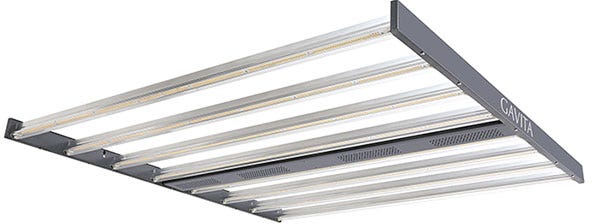
Gavita took the industry by storm with their 1650e LED, and quickly made improvements upon it to come out with the Generation 2. We have an entire review of the Gavita Pro 1700e Gen 2 LED, and currently, have it set up in our own grow tent!
We’re calling it the most efficient LED, so let’s talk about the specifics. Gavita set out to solve a huge problem in the commercial growing industry with this light — efficiency at scale. Because commercial facilities employ large numbers of grow lights, energy costs stack up fast. That’s why its important the LEDs used in these facilities are as efficient as possible.
The Gen 2 Gavita Pro operates at an insane efficiency of 2.6 µmol s-1 per watt. It is dimmable up to 50% when paired with the Gavita Master Controller, further increasing this efficiency. Despite also being incredibly powerful, it still costs just $27.91 per month in electricity.
This is an amazing LED grow light, and as you’ll see towards the end of this article, efficiency isn’t the only thing it wins in.
Yes, this is the Gavita Pro LED’s third appearance on this list. But, we stand by that! This truly is one of the best LED grow lights on the market, and it fits a 5' x 5' footprint to near perfection. That is why we consider it to be the best LED for a 5' x 5' grow tent.
Other than the footprint, it works so well in grow tent through its open bar design. Because heat can build up so easily in tents, its important that your light does not contribute to this. The Gavita Pro does just this, making it an awesome choice for 5' x 5' grow tents.
VIPARSPECTRA DIMMABLE SERIES PAR700
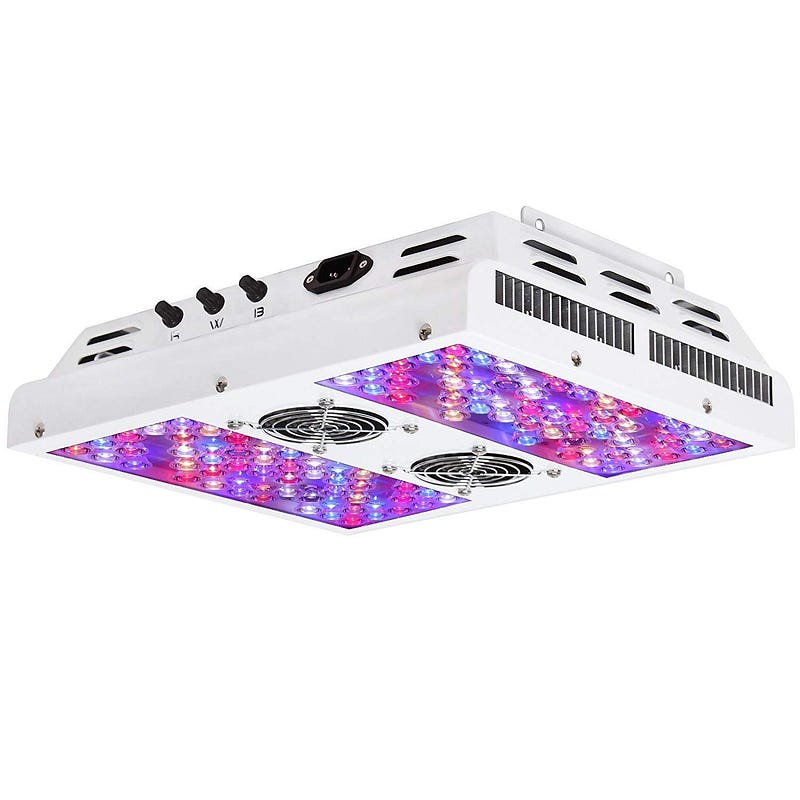
This is a smaller version of the VIPARSPECTRA PAR1200, and it is a 700W LED grow light, which is great at giving your marijuana plants a great boost when growing indoors without the sunlight.
As with all the Viparspectra LED grow lights, this one is also made to keep the balance between the coverage area, PAR value, and the Lumen power at optimum levels.
When you choose Viparspectra LED grow light, then you don’t have to worry about the quality or the performance of the light as they are all very excellent when it comes to these things. All the buyers who bought this grow light from Amazon gave this light a rating of 4.4 stars.
This is the best LED grow light for 3X3 and 2.5X2.5 feet grow tent. It will even consume less power than a traditional 600W HPS/MH grow light, meaning you will have savings on your electricity bills.
With this best small LED grow light, you don’t have to worry about the heating issues at all. It has three 3.2 inches cooling fans installed in it with a lot of heat sinks as well.
The heat sinks along with the cooling fans help all the hot air to escape and lets the cool airflow inside the grow light to keep things cool when the grow light has been working for long times.
This grow light also has three dimming switches for Red, White and Blue LEDs which can be used to dim/control the light intensity in the BLOOM and VEG modes.
Dimmers for the win!
The lens angle on this best LED grow light is of 90 degrees, which make the light penetrate more and reduces the light loss by a huge margin.
The overall warranty on this grow light is of 3 years along with a 30 days money-back guarantee.
Phlizon CREE COB 3000W LED Plant Grow Light
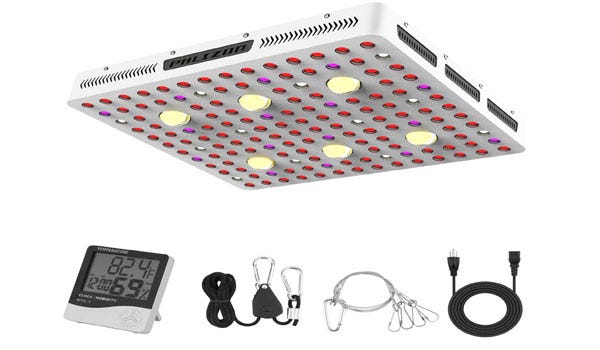
The phlizon is a well-known manufacturer. They produce excellent and professional led grow light and lights for growing aquarium plants. The CREE COB 3000W LED plants grow light is one of the best products by phlizon manufacturer.
There are several wattage options like 1000w, 1500w, 2000w, 2500w and 3000w. You should choose according to your growing area and plant sizes. But comparatively this 3000w Cree cob led plants grow lights have the highest yielding capability. For maximum output results, we recommend to use it in 4×4 grow tent.
The CREE COB is known for its higher brightness, stability, smaller thermal resistance, less light attenuation, and longer life. It has high PPFD Photosynthetic Photon Flux Density which promotes healthy plant growth.
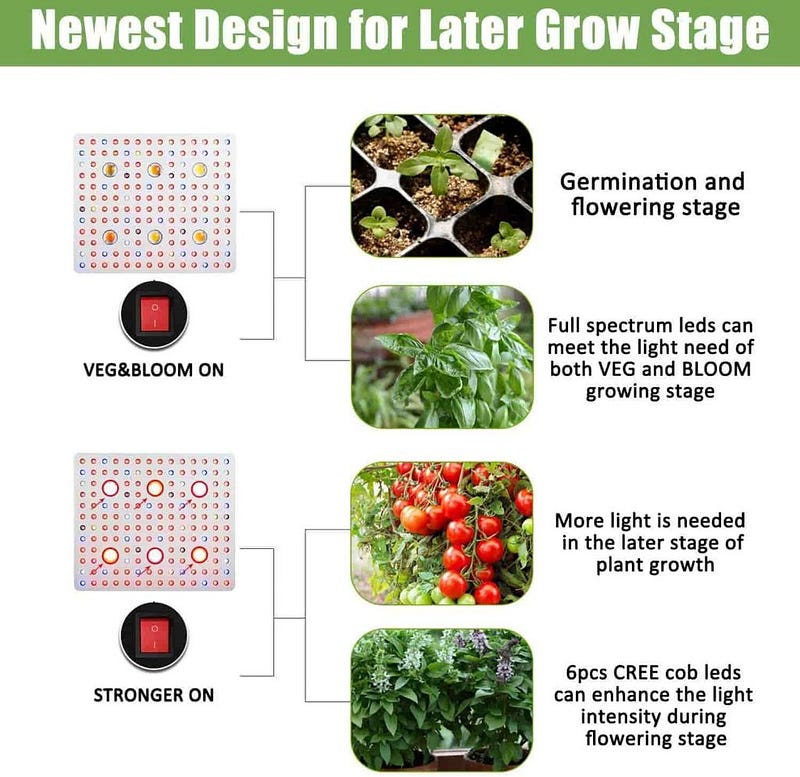
It comes with UV protection and fire-proof PC Cover and metal frame that ensure more durability and long-lasting performance (Lifespan: ≥ 50,000hours).
The price is small expensive than other competitive commercial led grow lights but a not bad investment for large scale led grow light.
Using Instructions:
Coverage Area: 48″*48″(4*4 ft) / Maximum 50″*50″(4.2*4.2 ft).
Germination Stage: Hanging at 30–40 inches above the plants and lighting 10–12 hours a day.
Seeding stage: hanging at 30–40 inches above the plants and lighting 12–13 hours a day.
Veg Stage: hanging at 24–30 inches above the plants and lighting 16–18 hours a day.
Bloom stage: hanging at 24–30 inch above the plants and lighting 12–13 hours a day.
Pro tips: for maximum yield, you should turn on the veg&bloom button in the germination stage and turn on the veg&bloom and stronger button together in the flowering stage.
How To Choose the Best LED Grow Light For Indoor Growing Plants
April 15, 2021
Look up the brand; website, socials, responsiveness
If you're going to spend a significant amount of money on a grow light, you want to be sure you're buying it from a good and reliable source. When you find an interesting light on Amazon, for instance, look up the brand elsewhere. Do they have a website? Do they have social media channels? Can you reach them on Facebook or by email? A complaint we often see in the business is that some brands don't reply to customer questions or emails. To us, this is ridiculous as we feel that a fairly expensive product should also come with good after purchase care.
One more thing. A high review count on Amazon doesn’t always equal a good product. As several news sites report (eg. CNN), there are plenty of fake or bought reviews floating around on Amazon. Apply critical thinking!
What Color Light is Best for Plant Growth?
Violet-blue light in the 400 – 520 nanometer range encourages chlorophyll absorption, photosynthesis, and growth.
Red light in the 610 – 720 spectrum range promotes flowering and budding.
Grow lights should provide the proper spectrum of light for photosynthesis, which key to plant growth. Before purchasing a light, be sure to check out the provided color spectrum. Lights that can provide a full spectrum are the ideal choice for your growing space.
This is where LED lights come in handy. Most LED growing lights offer both types of color spectrum lighting, so you can get all the benefits.
Red and blue light are crucial
If you would like to grow from seedling to flower, then a full-cycle LED grow light is recommended. A full-cycle grow light will provide your plants with the blue and red wavelengths that are needed for optimal growth. Blue light mimics the long day, summer sun and encourages vegetative leaf growth (MH, or Metal Halide, lamps also provide this function). When choosing an LED grow light ensure the unit includes blue lights in the range of 440-470nm. Red light is also important in plant growth and is a primary driver for photosynthesis. Red light takes the place of the short day, autumn sun. (HPS, or High Pressure Sodium, lamps provide a red-leaning spectrum). When combined with blue light, a hormone cascade is created and the red wavelengths begin to encourage flowering. Look for lights that have red light in the 640-660 range.
Many LED grow lights are full-spectrum grow lights and contain blue, green, red (which creates a white light or reddish light depending on the amount of green) and somtimes infrared (IR) and ultraviolet (UV). Greenlight, IR, and UV have been shown to increase plant growth (green light and IR) and flower quality (UV).
ECO Farm ECOZ 1000W Samsung 301H Chips LED Grow Light With Separately UV+IR Control

- Chanels Dimmers, VEG switch , Bloom switch ,UV switch separatly controlled, Freely adjust the lamps according to different growing stages;VEG dimmer to control white light 5000K, one Bloom dimmer to control white light +red light ( 3000K+660nm+730nm), and UV dimmer to control UV 395nm.
UV is a supercharger
In addition to red and blue diodes, you may consider a light that contains UV wavelengths. UV light activates the plant's defense mechanisms, affects plant development, growth, and metabolism. UV wavelengths can also increase THC. Choose LED grow lights that have diodes in the 315-400nm range (380nm is common.) UVA is a common LED wavelength used in grow lights. UVB is more expensive and is not seen too often in LED grow lights.
ECO Farm 30W LG UV395nm Supplemental Lighting Quantum Board

Grow area (light footprint)
Ask yourself, how many plants do you intend to grow? How big are they expected to grow? How large area does your light need to cover?
As light (and water and nutrients) is your plants' "food", if they receive less than required, the plants will not grow to their full potential, as per the picture above.
Not every square inch (or square centimeter, for non-US growers) of the plant needs maximum possible light coverage for the plant to thrive, but the majority (the more the better) of the plant should be well illuminated.
If you're growing cannabis, Indica strains grow smaller than sativas in general but it also comes down to how you manage the plant throughout its grow cycles. You can train the plant to grow a certain way and have a certain size.
Beginners that are still learning plant management will likely have smaller cannabis plants, around 2 square foot (0.2 square meters) per plant, than experienced growers.
Find a grow light or a number of grow lights that cover the area of your grow. Sometimes it makes more sense to buy two (cheap) lights rather than one expensive.
The area a light illuminates should be specified by the grow light manufacturer. If this info is not available, it suggests the seller is either withholding information or doesn’t really know how to best use the light.
Light output and intensity (PPFD)
Your plants need a certain amount of light to grow. To keep this guide short and in point, your weed plants will need around 300 PPFD (sometimes also incorrectly referred to as PAR) when they are small and in their vegetative stage, then about the double (600 PPFD) during flowering. Light will still be utilized beyond this level of intensity, but less and less efficiently. Experienced growers are often aiming for upwards 900 PPFD and with added CO2 and the right ratio of nutrients, temperature, and humidity, cannabis plants can take even a bit higher PPFD levels but 600-900 is still a good general rule of thumb.
Smaller plants like herbs (basil, rosemary, and microgreens) require about 150-200 PPFD for good results while veggies (cucumbers, peppers, tomatoes) need a bit more, 200-600 PPFD.
Don’t be Cheap
LED grow lights don’t come cheap. Regular LED bulbs for home lighting use are not as cheap as incandescent or fluorescent bulbs, so for LED grow lights that provide a life for plants, you can expect that these would cost a lot.
While you may find cheaper variants of LED grow lights, consider if it’s really worth it. Sometimes, cheap doesn’t always save money because of poor quality, which may even make you spend more on repairs or replacements. So, always choose the one that gives the best value.
The best LED spectrums for plant growth
In summary, the best lights for growing indoor plants will include red and blue LEDs (at the correct wavelengths) or a full-spectrum white light. UV diodes may be included to enhance a plant's physiological functions, but these are not required. A 6:1 or 5:1 ratio of red to blue is ideal for boosting yields, but can create stretched plants during Veg and reduce flower quality. A red to blue ratio or 2:1 or 1:1 is ideal for keeping stout and increasing resin production. Of course individual results will vary based on grower experience, strain, nutrients, environment, etc. Before you purchase and LED grow light, look at the spectral curve to ensure it is what you and your plants desire.
Understanding LED Light Output
We've seen a concerning trend in LED grow lighting which revolves around the promotion of false and misleading lamp wattage. This is important to indoor growers because the amount of photosynthetic light output a lamp produces is limited by the amount of wattage the unit draws from the wall. Lower light output levels will affect crop yield, potency and flavor profiles.

Advertisement with Misleading Claims
It's actual wattage is 330 watts. However it advertised as a 1200 watt grow light. That is a 300% inflation of actual light production output which is very misleading.
LED diodes output visible light energy in lumens or luminous flux. Each diode is supplied incoming voltage which is distributed to the diodes as a portion of the total amount of wattage the unit draws from the wall. Each LED light is limited to a specific maximum wall draw based on the voltage supplied to the Driver / Power Supply Unit. It varies slightly if the light is wired to accept 110/220/277 volts. But the variance is small as compared to the lamps wattage wall power draw.
Many of the products with inflated wattage claims also lack information on photosynthetic light output. The total amount of photosynthetic light being created is measured in a lab using a machine called an Integrating Sphere. The sphere measures total luminous flux output which can be translated to Photosynthetic Photon Flux or PPF. Nearly every manufacture or lighting worldwide owns an Integrating Sphere, and in order to secure UL or ETL safety ratings these products are also sent to third party labs who use a sphere to test the total light output versus energy consumed. We suggest that consumers buying LED lighting for indoor growing ask the supplier how much PPF the light is producing. This is important information needed to do side-by-side comparisons between grow lights. There are a lot of variables to consider when buying a grow light but at a minimum, the total amount of watts being consumed by the light (power draw at the wall) and the total amount of photosynthetic light (PPF) being created is important.
How Many PPFD Do Plants Need ?2021 Update
April 15, 2021
What is the PAR?
PAR (Photosynthetically Active Radiation) is an often used (and often misused) term. It is NOT a measurement or “metric” like feet, inches, or kilos. Rather, it defines the type of light (scientists call light “electromagnetic radiation”) needed to support photosynthesis in plant life. Through photosynthesis, plants convert light energy into chemical energy, which is the food they use to grow and thrive.
Interestingly, plants use roughly the same part of the spectrum that’s visible to the human eye, but the wavelengths we perceive to be the brightest (i.e. green light) are not the most efficient wavelengths for photosynthesis. As we all know, some light (like the light from a candle) is visible to the human eye and some (such as infrared) is not. Scientists define different types of light by their “wavelengths”. These different wavelengths make up the electromagnetic radiation “spectrum”. This spectrum includes X-rays, radio waves and infrared light (none of which are visible to the human eye) and light that we can see such as sunlight, and light from a red or blue LED.
So, the first thing to understand about PAR is that it is the part of the electromagnetic radiation spectrum (light) that is useful to plants and algae to activate photosynthesis -- it is NOT a measurement. What really counts is PPF, PPFD and DLI.
Photosynthetic Photon Flux (PPF)
The first measurement is Photosynthetic Photon Flux or “PPF” which measures the total amount of light that is produced by a light source each second. Put another way, PPF tells us how much PAR is emitted by a light source per second. More technically, PPF measures the “photosynthetically active photons emitted by a lighting system per second”. This measurement is expressed in “micromoles per second” and we’ll get to micromoles in a minute. Note though, that PPF does not tell us how much of the measured light actually lands on the plants or any other surface. It is probably the second most important way of measuring a lighting system, but, for whatever reason, 99.9% of lighting companies don’t list it. PPF is expressed by scientists and light engineers as: μmol/second.
Photosynthetic Photon Flux Density (PPFD)
The second measurement is PPFD which measures the light that actually arrives at the plant or algae. Photosynthetic Photon Flux Density or “PPFD” is a measurement of the amount of light that actually reaches your plants and algae or, as a scientist might say: “the number of photosynthetically active photons that fall on a given surface each second”. PPFD is a ‘spot’ measurement of a specific location on your plant canopy, and it is measured in micromoles per square meter per second. This measurement is expressed by scientists and light engineers as: μmol/m2/s.
Why do we want to measure PPFD and why is it important for grow lights?
Since it’s possible to measure both the PPFD output from grow lights and also determine the ideal PPFD levels for plants, the grow light’s output should match the plant’s needs.
Let's say you’re growing tomatoes in a 2x2’ (60x60 cm) tent and you know that tomato is a high light intensity crop that likes PPFD 600 µmol/m2/s and above. Naturally, a grow light matching this plant’s needs should be selected.
Or, if you’re growing microgreens, which are considered low light intensity plants, they will do well with PPFD 100-200 µmol/m2/s. These two scenarios would need very different grow lights.
General PPFD recommendations in µmol/m2/s:
|
Plant/maturity Clones, cuttlings, and propagation:
Young high-light plants, early veg: |
PPFD (µmol/m2/s) 75 150-300
200-300 300-400 |
Understand your plants’ or grow area’s PPFD needs then find a grow light with adequate performance.
Although plants don’t need maximum PPFD levels over their entire surface, averaging somewhere between 300-600 µmol/m2/s on most of the plant during flowering should be aimed for.
Here’s a tomato plant receiving 600 µmol/m2/s in the center and around 80 µmol/m2/s on its outer leaves.
Optimal Grow Light Size for Cannabis
To determine the optimal grow light size, it is important to consider the optimal PPFD (density of light) for growing cannabis and how that Optimal PPFD converts to an Optimal PPF (amount of light).
The Optimal PPFD for Cannabis:
The data from Chandra et al. confirm that the optimal photon density for peak cannabis photosynthesis is between 500 and 700 µmol/m2 (PPFD). It also shows that we should avoid going over 1000 µmol/m2 (PPFD) which could lead to damage. With artificial lighting, the distribution of light is never perfect. Therefore, we want to ensure that all areas of the canopy get at least 500 µmol/m2 (PPFD) and that no spot receives more than 1000 µmol/m2 (PPFD). We recommend an average of 700 µmol/m2 (PPFD). With most grow lights, an average of 700 will ensure that you stay within the optimal range for peak photosynthesis in all regions of the canopy.
The Optimal PPF for Cannabis:
PPFD is a density measurement which is expressed as micromoles per square meter. To convert PPFD into a quantity measurement, we multiply it by the area in square meters. Since the optimal average photon density is 700 µmol/m2 (PPFD), the optimal number of photons is 700 µmol Usable PPF per square meter. This converts to 65 µmol Usable PPF per Square Foot. To calculate the total amount of light that you need for your grow space in Usable PPF, simply multiply the square footage by 65 (Sq. ft x 65 = µmol Usable PPF).
OCL SKWID 1900 Pro LED 680W Grow Light VS Scopex 680W LED Grow Light
April 14, 2021
Are LEDs a Good Choice for Growing Cannabis?
LED grow lights are relatively new to the cannabis growing scene, but they have become wildly popular over the last few years with their ability to produce great yields while staying cool and using a reasonable amount of electricity.
Yields! With a quality LED grow light and an average-to-good grow, you can expect yields of about 0.5 to 1g/watt.
The final yield depends a lot on strain and grow skill, as well as the quality of the lamp itself, but that’s a good rule of thumb for most models. For example, a 200W LED (200W true power draw, not an “equivalent” wattage) would yield about 100-200 grams on average, or 3.5 to 7 ounces.
Today’s LED models are much better for growing cannabis than the ones available even a few years ago. Many modern lamps are full spectrum or “wideband” spectrum (instead of only red and blue light diodes, which product a bluish purple light and are sometimes called “blurples”). Full spectrum light is easier on the eyes and adding at least some amount of green light to blurples typically results in healthier growth. Other spectrum colors like red, far red, and infrared are important for the budding/flowering stage. LED manufacturers have developed specialized lenses to point light directly to the plants and increase penetration, resulting in bigger yields for the same amount of light compared to older models. There are also many different form factors, with everything from the casing to the size of the diodes varying from model to model.
Modern LED grow lights can produce impressive results. These cannabis plants were grown completely under LED grow lights from seed to harvest!
OCL SKWID 1900 PRO LED Light

- The OCL SKWID 1900 PRO LED is the next level in professional fixtures with the ability for central control with the OCL Lightning Touchscreen controller. With OCL lighting systems you are in control of the light! The OCL SKWID 1900 PRO LED growlight offers an absolute market leading PPF up to 1.938 μmol/s!
- A high-performance energy-efficient alternative to the traditional commercial 1000W DE HID fixtures.
- Developed for growers by growers whose cultivation is in low rooms, on vertical racks, over rolling benches, and in tents. For maximum uniformity, hang the fixture 6-12 inches from the crop.
- The efficacy of this fixture is very impressive at 2.9 μmol per watt. At 680 watts this will lead to 1938 μmol s-1 The eight bars are passively cooled in an extra wide shape to enhance spread and coverage. The absence of moving cooling parts reduces the possibility of mechanical failure.
- The OCL SKWID 1900 PRO LED is dimmable and delivers broad, full-spectrum light anywhere from 400w to 680w while maintaining efficiency. The dim switch on the driver makes it easy to control the light intensity. An optional OCL Lightning Touchscreen Controller can also be applied to achieve more complex dimming requirements.

TECHNICAL SPECIFICATIONS:
- AC Input Voltage: AC 100V-277V / 50-60Hz
- True Power: 680W
- Ampere: 3.1A @ 220V, 2.45A @ 277V
- LED Brand: Samsunglm301h+Osram
- Efficiency: 2.9umol/W at 640W
- Waterproof level: IP65
- Material: Aluminum
- Product Size: 1120*1100*100.5mm
- LED Driver: Inventronic LED Drivers
- Housing Color: Silver Color
- Control: Via an external controller/DimmingBoard
- N.G./G.W.: 16.35kg / 20.3kg
- Working temp: -20°~ 40°
- BTU: 2178
- Lifetime: 50000H
- Warranty: 5 years warranty
Scopex 680W LED Grow Light

SCOPEX combines outstanding efficiency, intensity and spread into one incredible plug-and-play array, the SCOPEX PRO horticultural LED light has all the latest and greatest features to give you both the power and control you need to get the absolute best results out of your space.
Scopex LEDs are supplied pre-built and folded for easy transport and installation.
SCOPEX-680-ADVANCED SPECIFICATIONS
Power Draw: 680w MAX
System PPF Output: 1850 μMol/S
System Efficacy: 2.72μMol/J
LEDS: Samsung LM301H & Osram Red
Waterproofing; IP65 light bars
Size: 112cm x 107cm x 6cm
Weight: 14KG
Area Coverage: Veg 2m x 2m - Flower From 1.2m x 1.2m to 1.5m x 1.5m
Warranty: 5 Year Full warranty from UK stock
Certifications: ROHS - CE - ETL
How to Choose an True Wattage LED Grow Lights 2021 Update
April 14, 2021
What are the benefits of LED grow lights?
Boosted growth, density, and resin production; tighter internodal spacing
Long bulb life; 50,000-100,000 hours (5 to 10+ years of consecutive use)
Energy efficient (30-50% more efficient than traditional lighting)
Lower heat-load / Reduced HVAC costs
No ballasts or reflectors, additional cooling equipment, or bulbs to replace
Spectrum, dimming, timing control (some fixtures)
Low profile (ideal for tiered racking systems)
Easy 'Plug-and-Play' setup
Safe to operate; No mercury
Wattage & Power Draw
LED Grow Light specifications include the Wattage, or Power of the light. However, there is a great deal of confusion over Wattage and actual Power Draw. Why are there even 2 different specs and how does the customer decipher what is really going on? For example, MARS HYDRO TS 1000W is 1000 Watt grow lights but the actual power draw as stated on the product spec page is 150 Watts. Why??
First let’s remember that Power (Watts) = Voltage x I(Current)
LED plant lights are grouped by the current (Amps) of the diodes within the light. 1 watt diodes generally run at around 0.35 Amps, 2 watt diodes run around 0.5 Amps and 3 watt diodes run around 0.7 Amps. Diodes are not maximized with current so that the manufacturer can increase the lifespan, reduce the heat output, and supply a better grow light. In addition, different color diodes have different wavelengths and require a different supply voltage for the specific wavelength. The red and orange wavelengths require around 1.8-2.7 Volts and the blue and violet wavelengths require 2.7-3.5 Volts. Hence, following our W = V x I equation, a 3 watt red diode may only have a power draw of 1.5-2.0 watts and a blue diode may only have a power draw of 1.8-2.5 watts. That is why we have the stated wattage of the light and the actual power draw. Hence, the 1000 Watt grow light has 342x3 watt diodes, but the actual power draw is 150 Watts. Some LED companies do not publish the actual power draw. Be careful of these companies and make sure you make an apple to apple comparison when it looking for the right LED for your given grow space.
How many watts of LED power do I need compared to HID lighting?
Generally, 30-50% less wattage is needed depending on the efficiency of the LED grow light. More efficient grow lights exude more light while using less watts. Remember, that this is actual LED wattage, also known as wall wattage, not the advertised LED wattage that might be found in the title of the LED grow light. For example, an amazon advertised '1200W' LED grow light might only draw 500W at the wall
How Much Power You Need

To grow marijuana, you want between 30 and 40 watts per square foot of grow space. Of course, more wattage will give you larger yields (within reason) and less wattage will result in smaller yields.
NOTE: We are using the actual power here (and also in our table below), not the rated power. LED diodes are never run at full power, as this would considerably shorten their life. A 3-watt chip for example, will only run at approximately 60% of full power.
So if a fixture has two hundred 3-watt diodes, it is technically capable of producing 600 watts of power, but it will actually only draw about 300 to 400. Most manufacturers will list the rated power (600 watts), but this is obviously a bit misleading.
So, continuing the example from above, you need between 480W led grow light (16 sq ft x 30 watts) and 640W led grow light (16 sq ft x 40 watts) of actual LED power.

Your best bet in this case is to go with a light that draws at around 600 watts of actual power for this grow area. In terms of listed wattage, that equates to around 1000 watts.
The table below shows the wattage needed for common grow area sizes. Naturally, most grow areas are far larger. Use the values below to calculate your requirement.
For example, a 1000 square foot space would need 30,000 to 40,000 watts in total.
You get this value by first calculating how many 100 sq ft areas are contained in one 1000 square foot area (1000 divided by 100 = 10).
A 1000 square foot area contains ten 100 square foot areas. This means it would need ten times the wattage.
From the table, a 100 square foot area needs 3000 to 4000 watts. Thus, a 1000 square foot area needs 10 times that, or 30,000 to 40,000 total watts.
FLUENCE SPYDR VS GAVITA PRO LED GROW LIGHT
April 12, 2021
FLUENCE SPYDR 2P LED GROW LIGHT SYSTEM
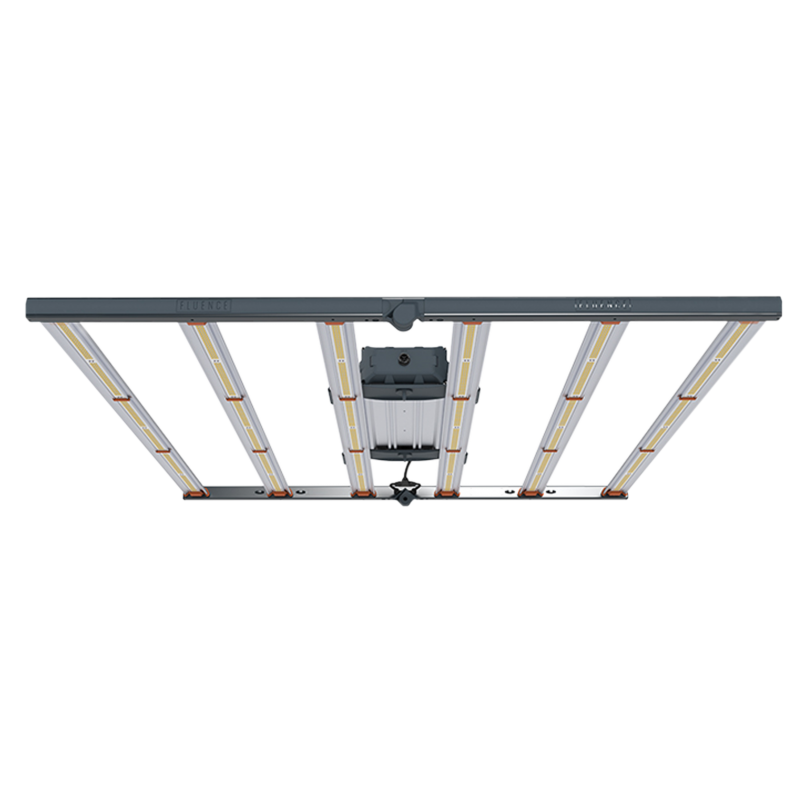
The Fluence SPYDR 2p is an improved, more powerful version of the SPYDR Plus. Just like the 2i, the SPYDR 2p is developed for High PPFD Cultivation, which makes the grow light in principle suited for growrooms in which extra CO2 is added to the air. A boosted quantity of CO2 of 800 to 1,400 PPM (normally this is 400 PPM, 0.04%), in other words, a percentage of 0.08 to 0.14%, will enable a plant to safely transform that huge light intensity into carbohydrates and energy. The beneficial effect for the grower is that, due to this, the life cycle of his plants is significantly accelerated and, additionally the yield is increased up to 20%. I.e.: High PPFD Cultivation will generate more crop in less time.
The SPYDR 2p resembles the 2i in many aspects, but the most important difference is the light intensity. The 2p is less powerful which makes this LED nursery lamp in principle also suited for growers that work without CO2. It is important however, to keep a minimum of 40 centimetres between lamp and plant. At a shorter distance, the light intensity will damage the plants.
The Fluence SPYDR 2p is fitted with a PhysioSpec Indoor spectrum, developed by Fluence themselves. This is a tailor-made spectrum for the indoor grower and intended for the entire life cycle of your plants. So, also seedlings, shoots and clones will feel very comfortable in the light of this lamp. The PhysioSpec Indoor spectrum scores 85 on the CRI-scale, meaning that the radiated light is excellently suitable for the work and research conditions in which natural, lively colours and proper contrast are essential. The Fluence SPYDR 2i does not include a built-in dimmer. This can be obtained separately only. One dimmer can be connected up to 50 SPYDR 2s.
The Fluence SPYDR 2p is a professional LED grow light, highly efficient in energy consumption. Thanks to the large light surface, the light is distributed quite evenly across the growth surface and will have no trouble penetrating the foliage. The materials used by Fluence, the straightforward design and the lack of fans make the Fluence SPYDR 2i a soundless, solid grow light that will last for many years, hassle-free. The Fluence SPYDR 2p can be connected to the mains electricity as stand-alone or in daisy-chain. This LED grow light is suitable for use in racking (vertical farming), cultivation tables and in grow tents. A hanging fixture is included.
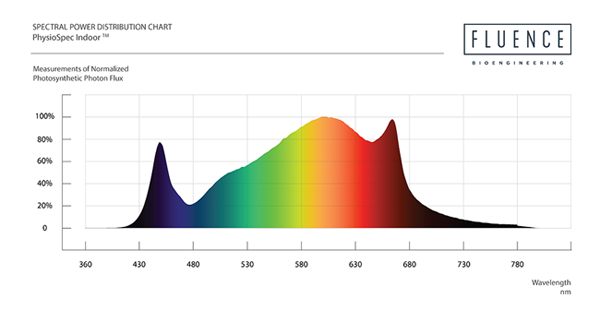
High PPDF-growing with CO2 requires knowledge of photosynthesis and the effect of CO2 on your plants. It is important to realise that in case of too little CO2 in the air, the bright light cannot be transformed into energy and carbohydrates, as a result of which your plants may get damaged. On the other hand, the additional CO2 in the growing area will only be transformed in case there is sufficient light intensity. Using the powerful Fluence SPYDR 2p that is one thing you needn’t worry about.
Gavita Pro 1700e LED Grow Light
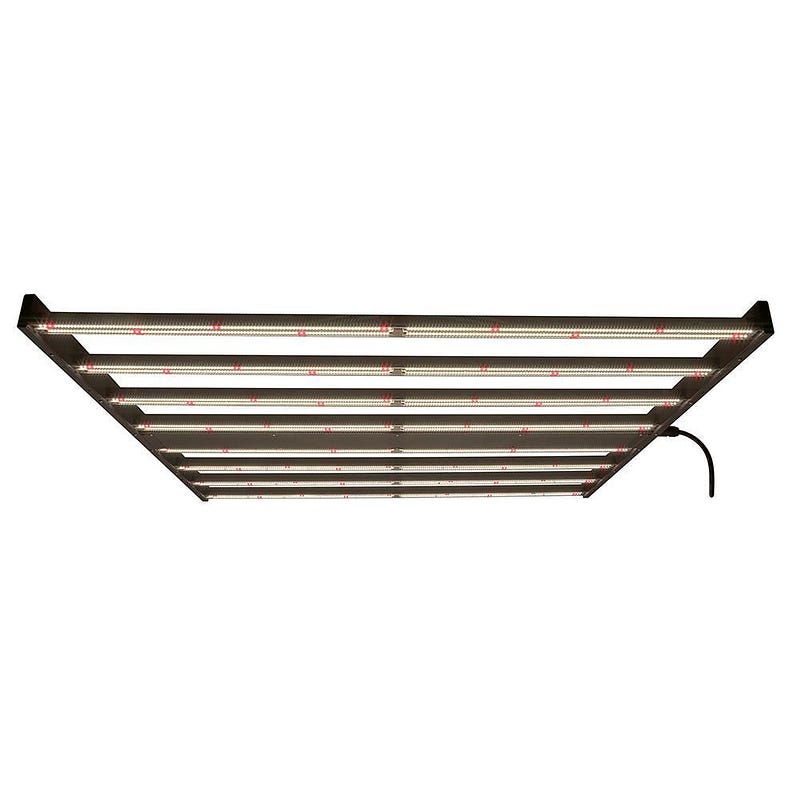
The Gavita Pro 1700e LED fixture operates at 645 watts with an output of 1700 µmol s-1 PAR and an impressive efficacy of 2.6 µmol s-1 per watt. The Pro 1700e delivers broad, intense light coverage with its 8 passively cooled LED bars allowing you to use it in low rooms, vertical racks, over benches, or even in tents. This powerful, full-spectrum light source is intended for full-term plant growth from the vegetative stage to the higher-light-requiring bloom and finishing stages. Built with premium Philips drivers, Samsung white LEDs and Osram deep-red LEDs, this fixture uses only the highest-quality components. The fixture is dimmable to 50% without any loss of efficiency using the Gavita E-Series LED Adapter and Gavita Master Controllers. The Gavita E-Series LED Adapter — 120–277 V (#906151, sold separately) is required for each fixture when using the controller; non-controlled fixtures simply operate at 100%. The Gavita Pro 1700e LED fixture and Gavita E-Series LED Adapter are FCC compliant, UL1598, and IP66 rated for use in wet environments with a maximum ambient operating temperature of 40°C. Sun Grip® light hangers included.
- 8 passively cooled bars eliminate moving parts and provide full-spectrum, broad-coverage light for full-term growth
- High-output 1700 µmol s-1 PAR and an impressive efficacy of 2.6 µmol s-1 per watt
- Dimmable to 50% when using the Gavita Master Controller and E-Series Adapter
- FCC compliant, UL1598 and IP66 wet-rated for use in wet environments, allowing for versatile placement in growing spaces with low ceilings, vertical racks, benches or even in tents
- Reliably sourced components including Philips Drivers, Samsung white LEDs and Osram deep-red LEDs make the 1700e built to last
- Sun Grip® light hangers included for quick, easy installation
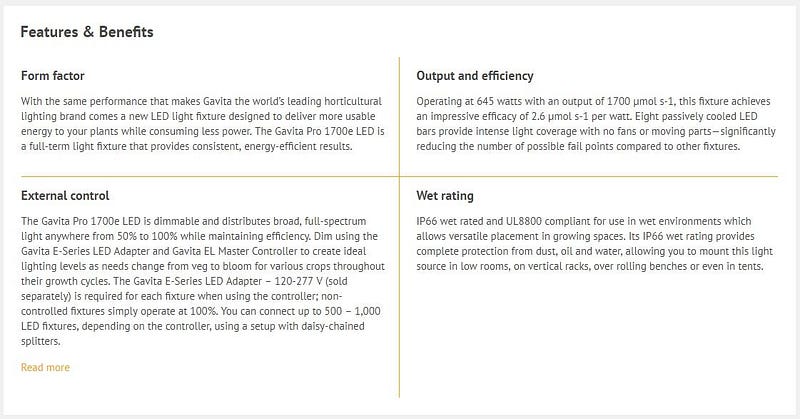
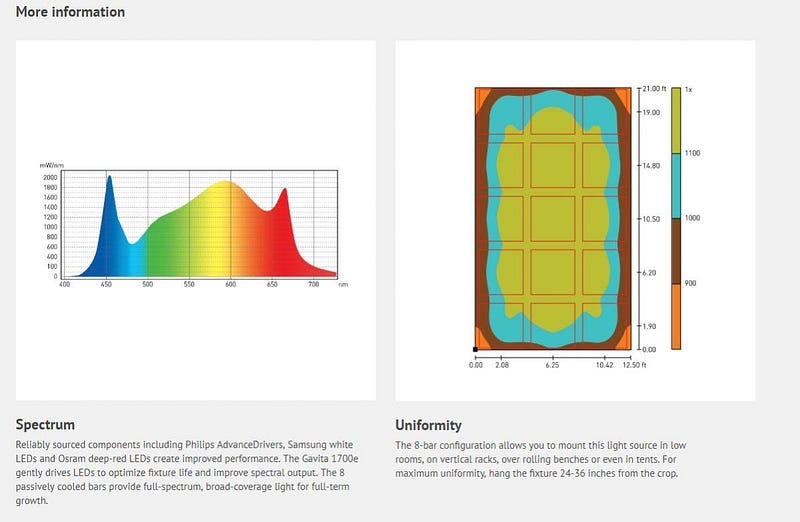
Rayonled GLM 640W VS ChilLED 600W LED Grow Light
April 12, 2021
Rayonled GLM 640W LED Grow Light
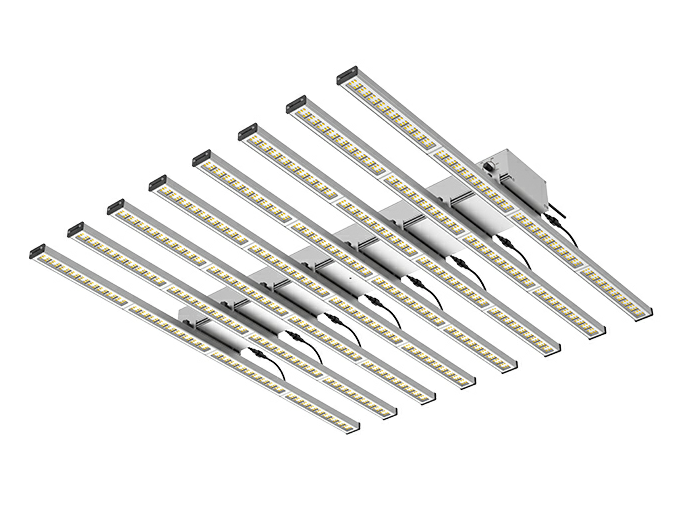
This LED grow light is the latest products from Rayonled’s team of engineers. Backed by their impressive expertise in LED technology, this medical grade unit has everything to appeal to both hobby and commercial growers.
Looking to bring you garden to the next level? Look no further. The GLM 640 is designed to replace and surpass the results from a 1000W HID fixture. From the spectrum to the certifications, it has been thoughtfully crafted to compete with the top grow light on the market.
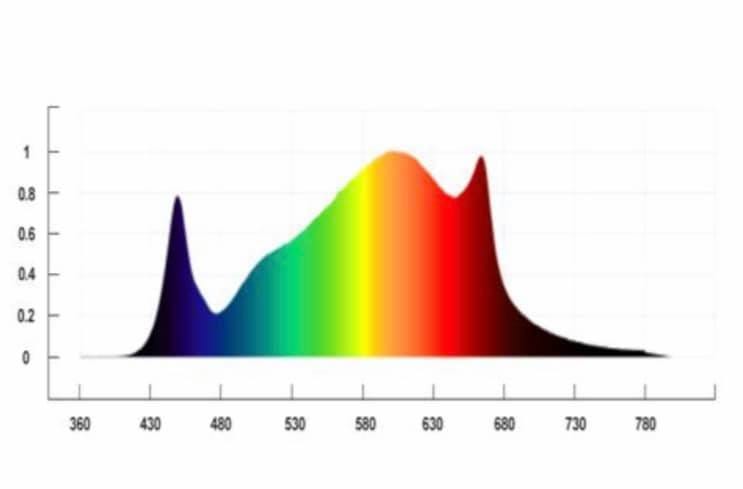
Key features:
- Proudly Canadian company.
- Passively cooled bars eliminate moving parts and provide full-spectrum, broad-coverage light for full-term growth
- High-output 1506 µmols PAR and an impressive efficacy of 2.35 µmol/s per watt
- IP65 certification allowing the light to perform and last even in the most humid grow rooms
- Independent bars and drivers ensure that even if a problem occurs the light can be repaired without losing the production of the entire fixture.
- Best-in-class durability testing. Instead of doing a regular 48h test on their lights Rayonled will test every fixture in a special oven that provides the highest standard of heat resistance.
- 5 Year warranty on all fixtures.
ChilLED Growcraft 600 Watt DIY Kit
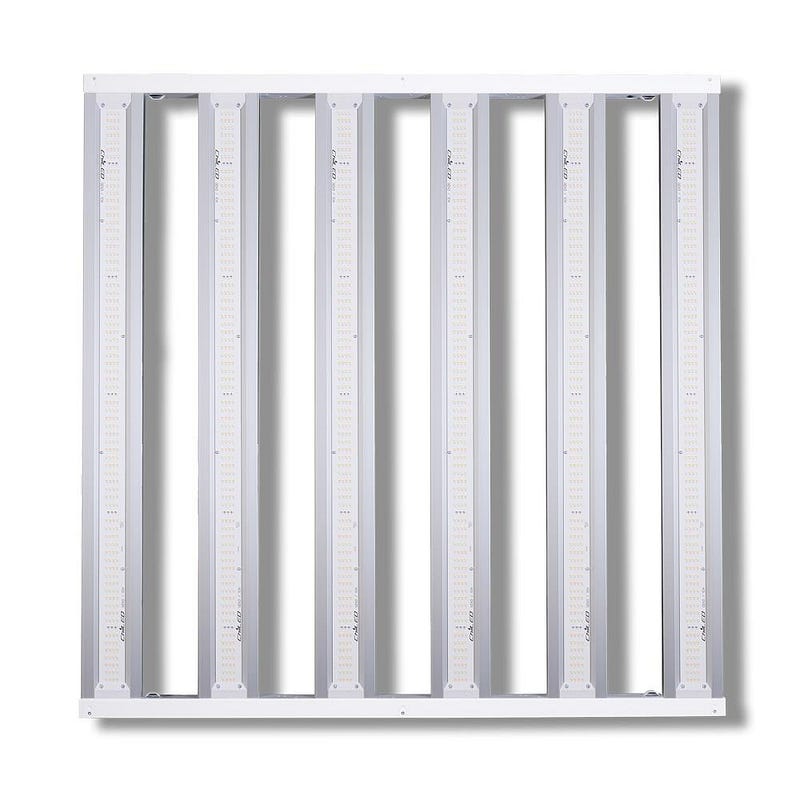
Home Engineers- Your DIY dream! Save money by building your own light fixture with easy to follow instructions and videos.
Results- Market-leading efficiency combined with our tunable Yield Max spectrum equals unmatched performance.
Quality- Highest build & component quality — never sacrificed for profits. ChilLED grow lights are built to last.
Versatility- Retrofit into your environment with ease. Hands down, ChilLED lights are the most versatile on the market.
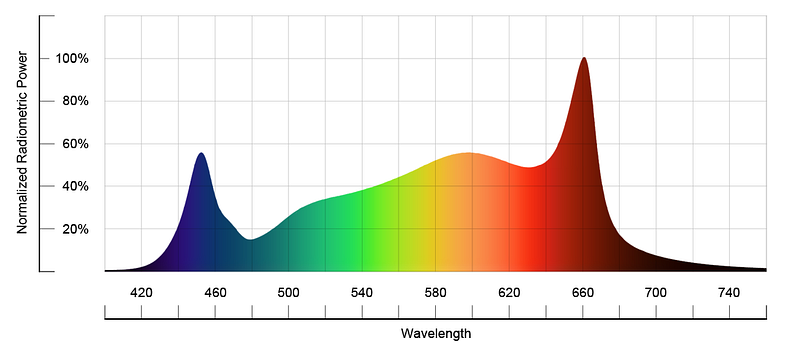
Top Features
DIY Friendly Modular Design — If you can dream it, you can build it!
U Frame Structure Platform — Provides ready-made framework — no need for drilling or tapping
Innovative Rugged LED Light Bar System — Large footprint for even canopy coverage
Slim Profile Passive Cooled Design — Only 1.375in thick & no moving parts
Growcraft Yield Max Spectrum — 3rd Gen 2020 technology — maximum results
Linear Power Control — 30W — 600W dimmable range
Light Engine Efficacy — 3.26 μmole/J — 2.93 μmole/J
Full System Efficacy — 3.13 μmole/J — 2.81 μmole/J

